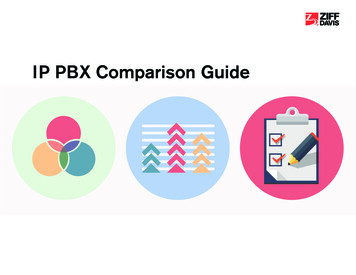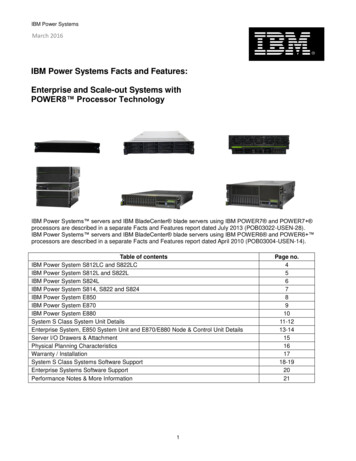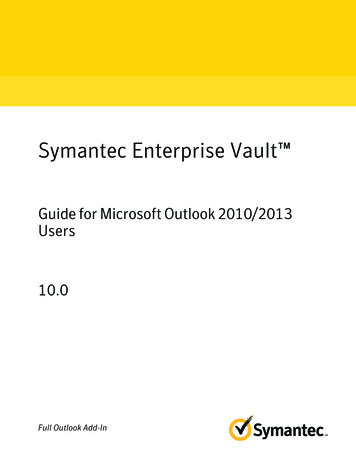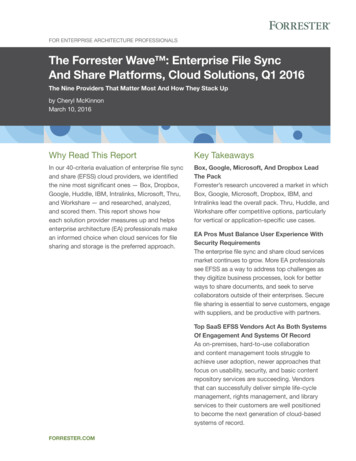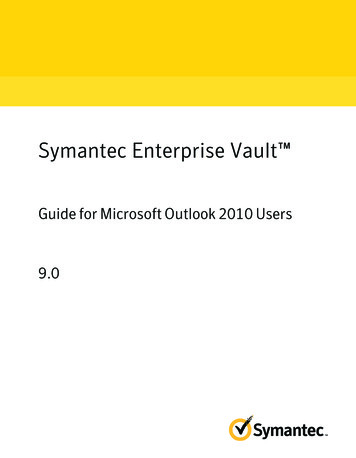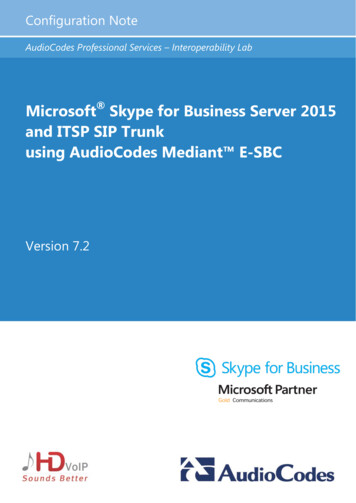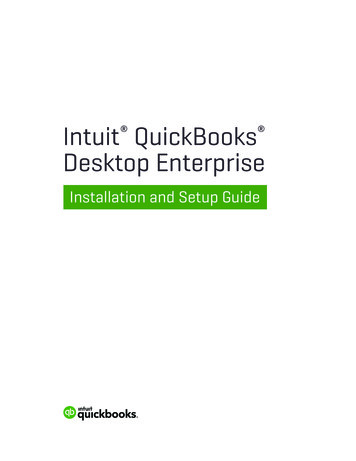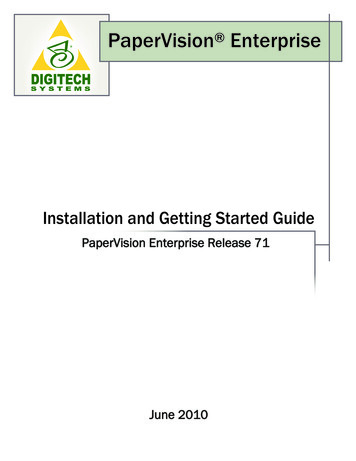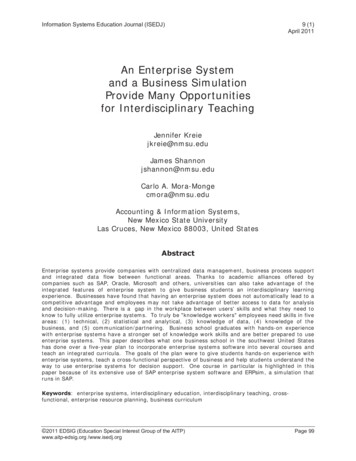
Transcription
Information Systems Education Journal (ISEDJ)9 (1)April 2011An Enterprise Systemand a Business SimulationProvide Many Opportunitiesfor Interdisciplinary TeachingJennifer Kreiejkreie@nmsu.eduJames Shannonjshannon@nmsu.eduCarlo A. Mora-Mongecmora@nmsu.eduAccounting & Information Systems,New Mexico State UniversityLas Cruces, New Mexico 88003, United StatesAbstractEnterprise systems provide companies with centralized data management, business process supportand integrated data flow between functional areas. Thanks to academic alliances offered bycompanies such as SAP, Oracle, Microsoft and others, universities can also take advantage of theintegrated features of enterprise system to give business students an interdisciplinary learningexperience. Businesses have found that having an enterprise system does not automatically lead to acompetitive advantage and employees may not take advantage of better access to data for analysisand decision-making. There is a gap in the workplace between users' skills and what they need toknow to fully utilize enterprise systems. To truly be "knowledge workers" employees need skills in fiveareas: (1) technical, (2) statistical and analytical, (3) knowledge of data, (4) knowledge of thebusiness, and (5) communication/partnering. Business school graduates with hands-on experiencewith enterprise systems have a stronger set of knowledge work skills and are better prepared to useenterprise systems. This paper describes what one business school in the southwest United Stateshas done over a five-year plan to incorporate enterprise systems software into several courses andteach an integrated curricula. The goals of the plan were to give students hands-on experience withenterprise systems, teach a cross-functional perspective of business and help students understand theway to use enterprise systems for decision support. One course in particular is highlighted in thispaper because of its extensive use of SAP enterprise system software and ERPsim, a simulation thatruns in SAP.Keywords: enterprise systems, interdisciplinary education, interdisciplinary teaching, crossfunctional, enterprise resource planning, business curriculum 2011 EDSIG (Education Special Interest Group of the AITP)www.aitp-edsig.org /www.isedj.orgPage 99
Information Systems Education Journal (ISEDJ)1. INTRODUCTIONDespite the fact that many organizations haveimplemented an enterprise system, such as SAP,many have not reaped the benefits. Theinvestment in technology and software do notlead to better decision-making if users cannottake advantage of the enterprise system.Enterprise systems users not only needtechnical software training but other essentialskills (Chian-Son, 2005; Robey, Ross, &Boudreau, 2002; Celsi & Wolfinbarger, 2001;Willcocks & Sykes, 2000). Davenport et al(2001)identifiedfivekeycompetenciesbusinesses need in their employees if they wantthem to make data-based decisions, i.e., usedata from the enterprise system for businessperformanceanalysis.Thefivekeycompetencies these knowledge workers need are(1) technical skills, (2) statistical and analyticskills, (3) knowledge of data, (4) knowledge ofthe business, and (5) communication/partneringskills. Technical skills include an understandingof enterprise systems software and knowledge ofsoftware used to extract and manipulate data.Statistical modeling and analytic skills include anunderstanding of modeling and associatedanalysis constraints in order to interpret dataanalysis. To get the data for analysis requiresknowledge of the data—what data are availableand where. Knowledge of the business providesthe context for interpreting data pertinent todecision-makers.Finally, communication andpartnering skills enable employees to coordinatewith others in addressing problems and makingdecisions for the business. Celsi & Wolfinbarger(2001) use the term “renaissance employee” forpeople with these skills that meld ective.The enterprise system software availablethrough academic alliances offered by majorsoftware companies such as SAP, Oracle,Microsoft and others, give business colleges theopportunity to provide students with aninterdisciplinary learning experience and thispaper presents an interdisciplinary teachingapproach taken by faculty at a university in thesouthwest.This approach helps studentsintegrate concepts from different businessfunctions and develop the key competencies tobe effective knowledge workers. One newcourse in particular, called enterprise resourceplanning (ERP), provides extensive experiencewith enterprise system software and businessprocesses through a simulation written to run inSAP. The simulation, called ERPsim, generates a9 (1)April 2011lot of transactional data in SAP which providesmany teaching opportunities in the ERP class.Presented here is an overview of this ERP courseand the ways faculty integrates accounting,finance, and information systems concepts in thecoursework. This paper also shows how to buildon the interdisciplinary experience for studentsby using data generated by the simulation incourses in other disciplines.In this article there are some examples of howcourses in accounting, finance, etc. can linkconcepts they cover to the concepts taught inthe ERP course and vice versa. For example, anaccounting course that teaches product costingor a finance course that covers performanceratios can be cross-referenced with the ERPcourse.Thisinterdisciplinaryteachingopportunity provides a cohesive learningexperience for students and reinforces theirunderstanding of cross-functional businessprocesses (Ferrara, 2007; Strong, Fedorowicz,Sager, Stewart, & Watson, 2006;Cannon,Klein, Koste, & Magal, 2004;Bradford,Vijayaraman, & Chandra, 2003). This approachis also more flexible than the team teachingapproach often proposed in recommendationsfor an integrated business curriculum (Ferrara,2007;(Smith Ducoffe, Tromley, & Tucker,2006).2. MULTIDISCIPLINARY TEACHINGOPPORTUNITYBackground for Five-Year PlanSeveral business faculty members developedand implemented a five-year plan to incorporateenterprise systems software into severalcourses. The reason for this plan was to givestudents an integrated experience with su.edu/erp)includedchanges to existing courses and a newenterprise resource planning (ERP) course withextensive use of SAP.Since enterprise systems software is complexand has a significant learning curve, the facultypicked one to focus on. SAP was chosenbecause of its standing as the industry leader inenterprise system software and the dn.sap.com/irj/uac).(Afewfaculty have also used other software, such asMicrosoft Dynamics' GP and Oracle EnterpriseApplications.) It was fortuitous that a newcurriculum benefit was added to the offerings inthe SAP academic alliance just as the ERP course 2011 EDSIG (Education Special Interest Group of the AITP)www.aitp-edsig.org /www.isedj.orgPage 100
Information Systems Education Journal (ISEDJ)was first offered. This new teaching tool wasERPsim, a complex but engaging simulation thatruns live in SAP (http://erpsim.hec.ca/). Thecombined experience of working with SAP andrunning a business via ERPsim in the ERP coursehas provided an excellent platform for buildingthe key competencies of students.Overview of the ERP CourseThe ERP course teaches concepts and providesexperiential learning.The concepts coveredinclude integrated business processes, demandforecasting, material requirements planning,supply chain management, data management(master and transactional data) and dataanalysis. There are several hands-on exercisesusing SAP through which students becomefamiliar with the software while they learn thedetails of the business simulation in whichstudent teams manage companies operating inthe same industry. The business simulation hasmanufacturing companies in the cereal industry.Teams of students run the ment,marketing, and product pricing.They mustimplement these decisions using SAP and theymust glean information from the large quantityof data the SAP enterprise system holds fordecision support. The simulation can have up toeight runs with each run lasting one class period(a run simulates 30 days).Coverage of course concepts are interjectedbetween simulation runs so the completion ofthe simulation takes several weeks.Oneexample of interleaving teaching with thesimulation: between two simulation runs, theteacher can take one or more class periods withthe students to discuss demand forecasting andits impact on material requirements planningand inventory management.During these“concepts” sections, concepts and terms can becovered in depth, followed by seeing theseterms put into practice during the simulation.The specific learning goals of the ERP coursehelp students build their skills in the targetedcompetencies for effective knowledge workers.Table 2 shown in Appendix A outlines thecoverage of key competencies in the ERP course.Students gain technical skills and learn aboutthe data that supports business processes. Theyanalyze data and use that information along withtheir understanding of the business, to makestrategic and operational decisions.Thesecompetencies also require a grounding in ing and management.9 (1)April 20113. INTERDISCIPLINARY TEACHINGThe data accumulated in the enterprise systemprovides many ways to develop exercises thatlink to concepts in different business functions.Two example exercises are presented below.Each example shows how teachers of the ERPcourse can use enterprise system data to teachconcepts from one of the business functionalareas. Just as important, these examples showhow the enterprise system data could be used incourses in other disciplines to enhance theinterdisciplinaryteachingexperienceforstudents. Without having students learn SAP,teachers in finance, accounting, marketing ormanagement, can still take advantage of the thedata extracted from the enterprise system.Capacity UtilizationFigure 1. Spreadsheet for CapacityUtilization AnalysisAn exercise in the ERP course that referencesaccounting. In a manufacturing company it isimportant to understand the concept of capacityutilization, a concept taught in cost accounting.In the ERP course capacity utilization is taughtthen students are given an exercise in whichthey must analyze their company’s productionvolume, the allocation of production facilityoverhead expense and the impact on per-unitcost for their products. The spreadsheet inFigure 1 shows production data in the first fourdata columns that were extracted from SAP for acompany. This data shows that total productionin one simulation run was 340,000 units and540,055 in the next run, with capacity utilizationof 45.3% and 72.0%, respectively. For this partof the exercise students took the data extracted 2011 EDSIG (Education Special Interest Group of the AITP)www.aitp-edsig.org /www.isedj.orgPage 101
Information Systems Education Journal (ISEDJ)from SAP and built the spreadsheet to comparetotal production with production capacity.Next in this exercise, students use a customizedscreen in SAP that shows the impact of capacityutilization on the estimated per-unit cost. Figure2 in Appendix B shows the per-unit cost for oneproduct based on the assumption thatproductivity or capacity utilization is 75% (this isthe level the companies start with in productcost estimates). In the lower half of the productcosting screen the profitability analysis sectionshows the estimated cost per unit whenoverhead is allocated (the “Inc. Fixed” columnheading). One box of this muesli cereal costs3.26 to produce.In this part of the exercise students are asked tocompare their company's capacity utilizationwith the standard assumption of 75%. The nexttwo figures in Appendix B show there is adramatic difference in cost per unit whencapacity utilization goes below 75%. At 45%,Note: In the Profitability Analysis section, “Incl.Fixed” is the estimated product cost overheadwith included. The column labeled "variable"shows raw material costs and the columnsstarting with “DC” show the unit selling price inthree distribution channels.Figure 3 shows the cost of production for thismuesli cereal went from 3.26 to 4.35. Figure 4shows that capacity utilization of 72% stillresults in a notably higher per-unit cost (3.33versus 3.26)An exercise that cross-references the ERPcourse. In a cost accounting course, a similarexercise can be used as a introduction toproduct costing. With a short introduction to thesimulation scenario, students in the accountingcourse can understand the type of business andproducts in the SAP simulation. If any studentsin the class have taken the ERP class, however,they could tell the other students about theircompany and the decisions they faced.Noknowledge of the enterprise system softwareitself is needed in the accounting class. Theaccounting course could look at product costingin more detail for this simulated company anddiscuss the simplifying assumptions used in theallocation of overhead in the simulation.Financial Ratios–Solvency and Profitability9 (1)April 2011can view--much like real-world, publicly reportedfinancial data for companies. Table 1 shows fiveratios reported for one company over foursimulation runs. Though this company's ratiosshow steady improvement, there are often twoor three companies during a semester ground—perhapsprovidingmoreinteresting analysis and interpretation.Table 1. Financial Ratios For One CompanyOver Four Simulation 1Although the simulation does the calculations foreach company’s ratios and displays these as asummary after each simula
details of the business simulation in which student teams manage companies operating in the same industry. The business simulation has manufacturing companies in the cereal industry. Teams of students run the companies—making decisions about production, procurement, marketing, and product pricing. They must

